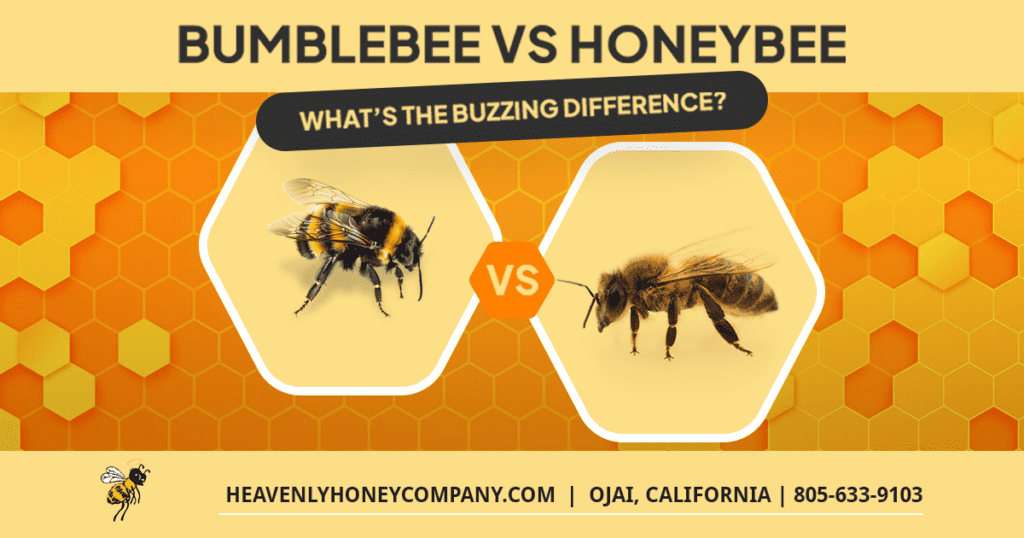
The Heavenly Honey Company of Ojai is proud to share everything you need to know about these fascinating creatures: the bumblebee and the honeybee. Both bees are important pollinators that help make our beautiful California gardens, crops and wildlands flourish. But when it comes to bumblebee vs honeybee, what exactly are the differences? What are the similarities? Is a bumblebee a honey bee? Let’s explore the buzzing world of bees and dive into the details.
Savor the Sweetness: Your New Favorite Treat Awaits
Raw Unfiltered Honeys
Indulge in the pure, unfiltered goodness of our raw unfiltered honey—harvested straight from the hive to your table. Our honeys capture the vibrant flavors and nutrients that only unprocessed honey can offer, preserving the natural enzymes, pollen, and antioxidants. Whether drizzled on toast, stirred into tea, or enjoyed by the spoonful, each jar provides a taste of nature at its finest. Shop Now to experience the full richness of raw honey, crafted by bees and perfected by nature.
Cold Process Soaps
Transform your daily routine with our cold process soaps, handcrafted with a blend of natural ingredients and botanical infusions. Each bar is carefully created to cleanse and nourish without harsh chemicals, giving your skin a gentle, moisturizing lather that only nature can provide. With scents inspired by the delicate aroma of flowers and the earthy undertones of honey, our soaps bring a touch of the outdoors into your bath. Browse Our Collection for a truly refreshing and rejuvenating skincare experience.
Custom Blend Loose-Leaf Teas
Awaken your senses with our custom blend loose leaf teas, made from the finest organic ingredients and expertly crafted to deliver a rich, satisfying taste in every cup. Each blend is designed to bring out the unique flavors and aromas of natural herbs, flowers, and teas, creating a one-of-a-kind tea experience that delights from the first sip to the last. Perfect for moments of relaxation or as a delightful accompaniment to your daily routine, our teas offer an exquisite, handcrafted flavor profile. Explore Our Teas and elevate your tea time with the artistry of loose leaf.
Now let’s jump into the key differences of honeybees vs. bumblebees!
Honeybee vs Bumblebee: The Key Differences
When discussing the difference between a honey bee and a bumblebee, many people may wonder whether these two bee species are similar or completely different. Let’s start with what sets them apart:
- Appearance: One of the easiest ways to tell the difference between a honey bee and a bumble bee is by looking at their size and shape. Honeybees are typically more slender with golden stripes, while bumblebees are bigger, rounder, and covered in fuzzy black and yellow hair.
- Nest Location: Honeybees are known for building large colonies and honeycomb cells in hives that are often found in trees or man-made beehives. Bumblebees, on the other hand, often prefer to nest underground, such as in abandoned rodent burrows. This is a major honey bee and bumblebee difference that makes it easy to identify their homes. Bumblebees may also create nests above ground in thick grass or under sheds.
- Honey Production: What’s the difference between a bumblebee and a honey bee when it comes to producing honey? Honeybees are the clear winners. They collect nectar and turn it into large quantities of honey, which we love to enjoy in our tea or on toast. Bumblebees also collect nectar, but they produce only small amounts of honey—just enough to feed their colony.
- Pollination Technique: There are distinct contrasts between bumblebee vs honey bee pollination methods. Bumblebees are exceptional at buzz pollinate, a technique that allows them to release pollen by vibrating their bodies. This makes them particularly good at pollinating certain types of flowers that require this unique method. Honeybees, on the other hand, are also important pollinators but do not buzz pollinate. H oney bees are more adept at transfer pollination. As they collect nectar, they come in contact with the flower’s pollen, when they go to the next flower some of the pollen from the previous flower rubs off and this goes on through the entire foraging trip.
- Activity: Bumble bees are versatile foragers! They can work in tricky conditions that honey bees can’t, like when it’s a bit dark, chilly, or even drizzling, making them highly adaptable to variable environmental conditions.
- Noise output: The bigger the bee, the slower its wings flap, so the sound is lower. Honey bees make a gentle buzz, while bumble bees make a much louder buzzing sound, which is more apparent when they buzz-pollinate.
- Communication: Honey bees are amazing dancers! They do a special dance to tell each other about good places to find food, like flowers rich with nectar. They also dance to let others know they’ve found a great spot to build a new home. Bumble bees don’t dance, but they use special smells (pheromones) and wing movements to talk to each other.
What are the Fundamental Similarities between Honeybees and Bumblebees?
While differences indeed exist, there are also many things that these two species have in common. The following are characteristics that are shared by bumblebee and honey bee alike:
- Honey bees and bumble bees both make honey through the collection of pollen and nectar.
- A hierarchy exists in both species, including drone bees, worker bees, and a queen bee.
- Both are considered important pollinators of flowers.
- Each bee species will protect its colony by stinging.
Honeybee vs Bumblebee Sting: Are They Different?
Another common question people have is about stings. When comparing honey bee vs bumblebee sting, there are notable differences. Honeybees can only sting once, as their stingers are barbed and remain in the skin, causing them to die afterward. Bumblebees, however, have smooth stingers, which means they can sting multiple times if they feel threatened—though they are generally the less aggressive of the two.
Nesting Habits and Behavior
Bumblebees and honeybees have different nesting habits. Honeybees build large colonies with complex honeycomb cells, often consisting of thousands of worker bees. Bumblebees, on the other hand, have smaller colonies and often nest in hidden spots, such as underground or in thick grass.
Honeybees and bumblebees also differ in terms of their activity. Bumblebees are usually more active in cooler temperatures, which makes them effective pollinators even in the early spring. Honeybees prefer warmer weather, which means they’re busiest in the heat of summer.
Bumblebee vs Honeybee vs Wasp
When it comes to honeybee vs bumblebee vs wasps, it’s important to remember that wasps are not bees at all. Wasps tend to be more aggressive and don’t have the fuzzy appearance of bees. They also do not produce honey or play as significant a role in pollination as bees do. Wasps usually build their nests above ground, often under eaves or in trees. One important thing to remember about wasps is they do not have a barbed stinger meaning they can sting repeatedly whereas the honeybee can sting only once.
Bumblebee vs Honeybee: Other Bee Species
In addition to honeybees and bumblebees, there are other types of bees you might come across.
- Sweat bees, for example, are smaller bees that are attracted to human sweat. They also play a role in pollination, though on a much smaller scale compared to honeybees and bumblebees.
- Carpenter Bees typically make their nests in dead wood or bamboo and tend to gather in smaller social groups.
- Mason Bees are known as solitary pollinators who like to nest within tunnels. Each female acts as a queen, and though she is without a colony, she still lays eggs and cares for the offspring until they emerge.
- You’ve likely heard of the hybrid Africanized or “Killer Bees;” these species are known for their hostility, chasing people further than a quarter mile in some cases. Africanized bees were formed by the mating of Brazilian honeybees and southern African bees.
- Leafcutter Bees nest in cavities within wood or even small twigs, and are known for their strong pollination skills with farm crops. It would take twenty honeybees to equal the work of one Leafcutter Bee!
Understanding the differences between these bee species helps us appreciate the variety of important pollinators in our environment.
Conclusion: Appreciating Our Busy Pollinators
Whether it’s a bumble bee compared to a honey bee, or simply understanding what makes each species special, both types of bees are crucial to our ecosystem. Without these important pollinators, many of the fruits, vegetables, and flowers we enjoy wouldn’t be able to grow. So, the next time you see a bumblebee or a honeybee buzzing around, take a moment to appreciate their hard work in keeping our world blooming.
FAQs
What is the difference between a bumblebee and a honey bee?
Bumblebees are larger, fuzzier, and nest underground, while honeybees are smaller, slimmer, and build large hives above ground. Honeybees also produce more honey than bumblebees.
Are bumblebees and honeybees the same?
No, they are different species. Bumblebees are larger and fuzzier, and they nest underground, whereas honeybees are slimmer, nest above ground, and produce large quantities of honey.
What’s the difference between a bee versus bumblebee?
“Bee” is a general term that can refer to many types of bees, including honeybees, bumblebees, and even sweat bees. A bumblebee is a specific species known for its larger, fuzzy body.
What’s the difference between a bumble bee vs honey bee sting?
A honeybee can sting only once, as its stinger is barbed. A bumblebee, however, can sting multiple times because it has a smooth stinger.
What’s the difference in these bees?
There are many bee species out there, but the main differences between bumblebees and honeybees are in their appearance, nesting habits, honey production, and sting behavior.



